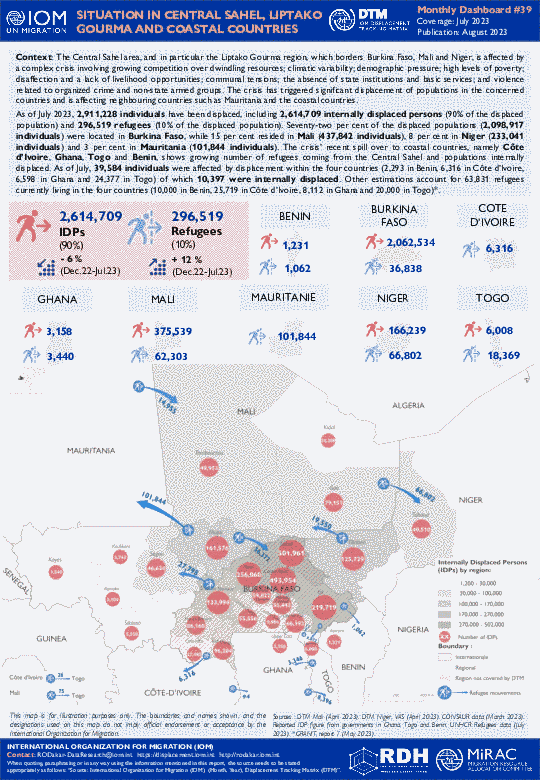-
Countries
-
Data and Analysis
-
Special Focus
-
Crisis Responses
West and Central Africa — Liptako Gourma and Central Sahel Situation Monthly Dashboard 39 (July 2023)
The Central Sahel area, and in particular the Liptako Gourma region, which borders Burkina Faso, Mali and Niger, is affected by a complex crisis involving growing competition over dwindling resources; climatic variability; demographic pressure; high levels of poverty; disaffection and a lack of livelihood opportunities; communal tensions; the absence of state institutions and basic services; and violence related to organized crime and non-state armed groups. The crisis has triggered significant displacement of populations in the concerned countries and is affecting neighbouring countries such as Mauritania and the coastal countries.
As of July 2023, 2,911,228 individuals have been displaced, including 2,614,709 internally displaced persons (90% of the displaced population) and 296,519 refugees (10% of the displaced population). Seventy-two per cent of the displaced populations (2,098,917 individuals) were located in Burkina Faso, while 15 per cent resided in Mali (437,842 individuals), 8 per cent in Niger (233,041 individuals) and 3 per cent in Mauritania (101,844 individuals). The crisis’ recent spill over to coastal countries, namely Côte d’Ivoire, Ghana, Togo and Benin, shows growing number of refugees coming from the Central Sahel and populations internally displaced. As of July, 39,584 individuals were affected by displacement within the four countries (2,293 in Benin, 6,316 in Côte d’Ivoire, 6,598 in Ghana and 24,377 in Togo) of which 10,397 were internally displaced. Other estimations account for 63,831 refugees currently living in the four countries (10,000 in Benin, 25,719 in Côte d’Ivoire, 8,112 in Ghana and 20,000 in Togo).

